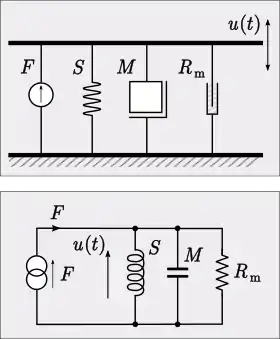Structural analog (electronic)
Despite the field diversity, all structural analog analysis use some level of abstraction to transform models in mathematical graphs, and detected structural analogies by algorithms. Example: for molecular structure comparison and classification operations, the compared compounds are modeled as a mathematical graph.[1]

A mechanical network diagram of a simple resonator (top) and one electrical network with an equivalent structure and behaviour (bottom), then, an analog for it.
Analogical models are used in a method of representing a ‘target system’ by another, more understandable or analysable system.
Two systems have analog structures (see illustration) if they are isomorphic graphs and have equivalent (mapped) lumped elements. In electronics, methods based on fault models of structural analogs gain some acceptance in industry.[2]
References
- C Ashby et all (2013), "New enumeration algorithm for protein structure comparison and classification", BMC Genomics DOI:10.1186/1471-2164-14-S2-S1
- "Analog Automatic Test-Pattern Generation", M. L. Bushnell, V. D. Agraval
This article is issued from Wikipedia. The text is licensed under Creative Commons - Attribution - Sharealike. Additional terms may apply for the media files.